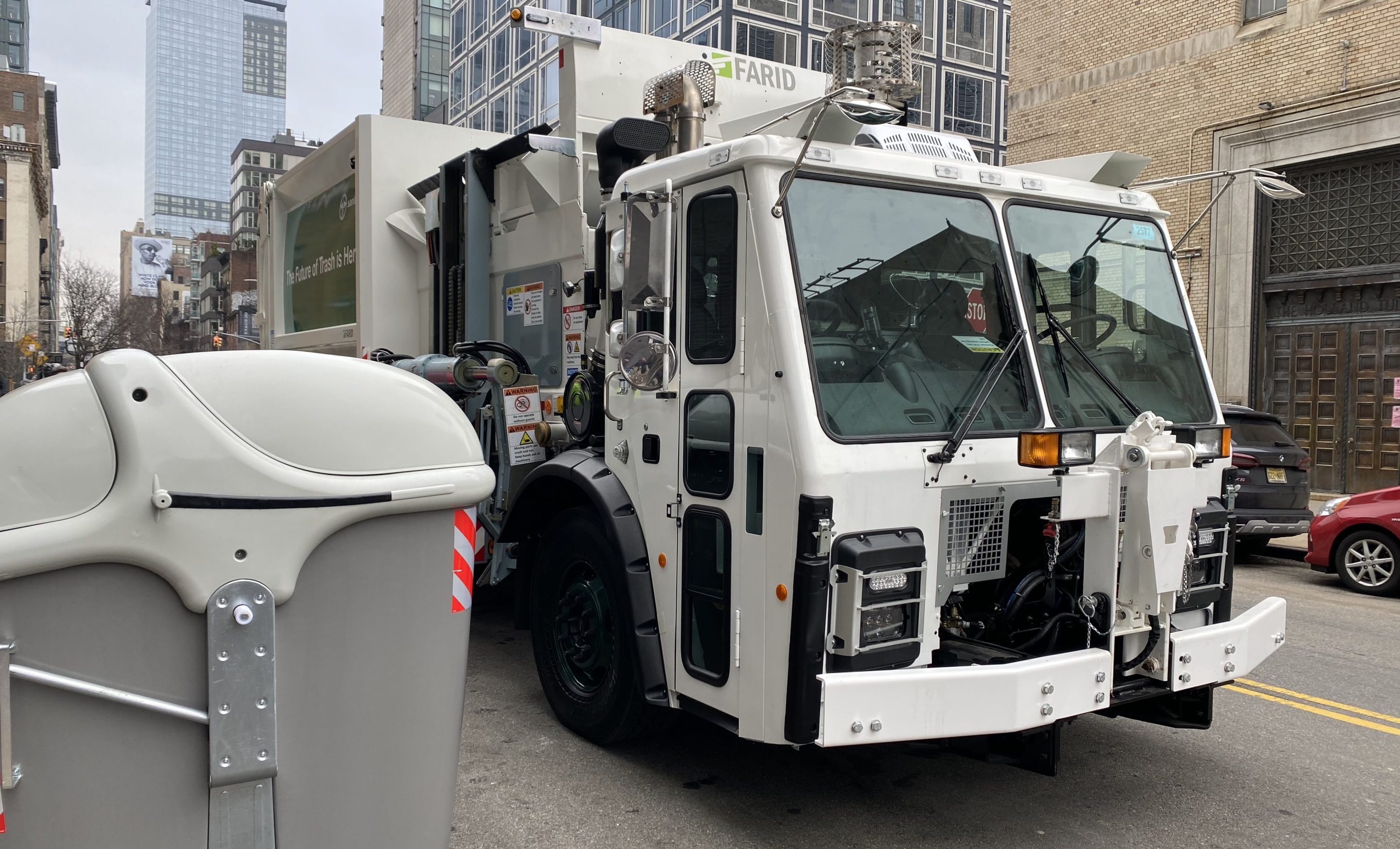The city will roll out new stationary curbside trash containers and custom side-loading trucks to hoist them in West Harlem next year, a major improvement and expansion on a successful pilot that put garbage where it belongs in the curb lane, officials announced on Thursday.
Buildings with 31 units or more in Manhattan Community Board 9, which stretches northwest from the top of Central Park, will get fixed trash enclosures in the curb lane by spring 2025 as part of the Department of Sanitation's effort to rid the Big Apple of mountains of garbage bags on the sidewalk with a collection method long employed in leading cities such as Barcelona, Singapore and Buenos Aires.
Mayor Adams and Sanitation leaders showed off the new truck at the agency's Spring Street garage in Manhattan.
"The truck you see next to me represents the future of New York City garbage collection," Adams said at the press event after hopping out of the passenger seat of the new waste hauler.
New garbage truck pic.twitter.com/VWERBEe6u1
— Kevin Duggan (@kduggan16) February 1, 2024
DSNY in September began collecting residential trash from wheeled containers in the street between W. 143rd and W. 152nd streets and outside all schools in the district, and rat sightings dropped by 68 percent over the previous year in that area, according to the agency.

Housing complexes in the northern Manhattan area with between 10 and 30 apartments can choose between the street-side containers and wheeled containers on the sidewalk.
Buildings with nine or fewer apartments across the Five Boroughs have to use wheeled containers on the sidewalk starting this fall — a Sanitation rule announced last year that covers about 41 percent of the city housing stock.
The agency will release a request for proposals next month for the new stationary bins and purchase 12 custom-made mechanized collection trucks that can hoist up and empty the containers from the side of the vehicle, officials said.
The announcement marked an important step toward addressing DSNY’s vehicle procurement challenges, and the agency’s Commissioner said they were able to get the prototype — a mix of an American and a European truck — four years faster than engineers expected.
"We took an American truck chassis — the same engine and cab our sanitation workers already use — and a European body with an automated side-loading mechanism, and engineered them to work together, which, I have to say, was no small feat," Tisch said.
The city currently pays between $450,000–$490,000 per Sanitation collection truck, and building the prototype cost nearly 20 percent more, according to agency spokesman Joshua Goodman. That would be as much as $588,000, but the rep said they expect the cost for the side loaders to end up somewhere between those two figures.
DSNY has a total fleet of 2,200 collection vehicles, so replacing all the trucks would cost more than $1 billion under the old price, though trucks are routinely replaced as they age beyond their work life.
New York's Strongest will also study the environmental impact for the proposed district-wide trash collection expansion ahead of the rollout.
The larger buildings will have their own bins, unlike other countries where residences share containers, according to DSNY officials.
Trash experts and advocates said the city should require more midsize and smaller buildings to use the bins in the street and allow them to share the enclosures, to avoid more bins clogging up the sidewalk.
And the pilot is so far also only for trash, and DSNY should include recyclables, said Clare Miflin, an architect and the founder of Center for Zero Waste Design, who has been advocating for waste containerization since her 2021 Put Waste to Work campaign.
"It’s great to do a larger pilot so they can really see the difference it makes to the rats and streetscape," said Clare Miflin. "With just a little more planning and thought they could achieve so much more."
Row houses and buildings up to 30 units should have to share containers in the street, said Miflin, because individual bins would gobble up too much sidewalk space. It's an issue trash reformers have raised with when DSNY started requiring commercial trash go in bins on the foot paths.
"The sharing is critical to preserve space," said Christine Berthet, founder of the pedestrian advocacy group CHEKPEDS, who has long pushed for moving trash into the street, and who worked on a previous containerization effort with the city. "You are not occupying as much pedestrian space, nor as much parking space."
Large buildings could also stage four-wheeled bins in the street temporarily, according to Miflin, which she said would take less than half the area compared to leaving containers out permanently, and would allow the street space to be repurposed for deliveries and other uses later in the day.
"I’m totally for containerization but my bottom line is, use it to improve streetscapes, not make them worse," she said. "If we’re going to have bins lining all our sidewalks and in front of our storefronts, it just makes it worse. Worse economically for brick and mortar businesses, and worse for the quality of streetscapes."
The agency last year released a detailed report investigating how to finally remove the Big Apple’s disgusting "5 o’clock shadow" of garbage bags and replaced them with closed containers.
The study found that the city could transition to garbage enclosures for 89 percent of residences, with rolling bins on the sidewalk for smaller buildings and larger boxes in the street for bigger housing complexes, the latter of which officials estimated would replace about 150,000 parking spots with the containers — a mere 5 percent of the total 3 million spaces the city currently allocates largely for free to car owners.
DSNY did another analysis of trash volumes by residence to decide where to make its latest cut off, according to officials.






